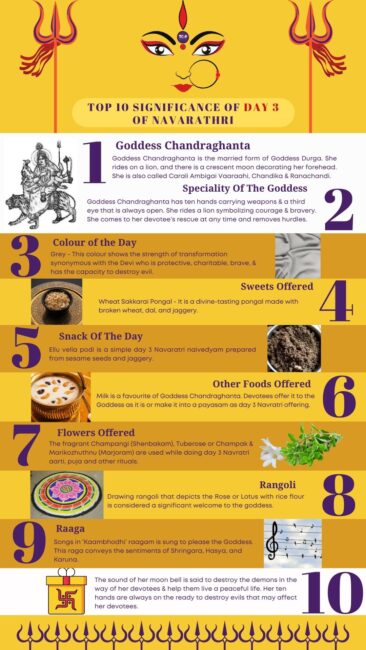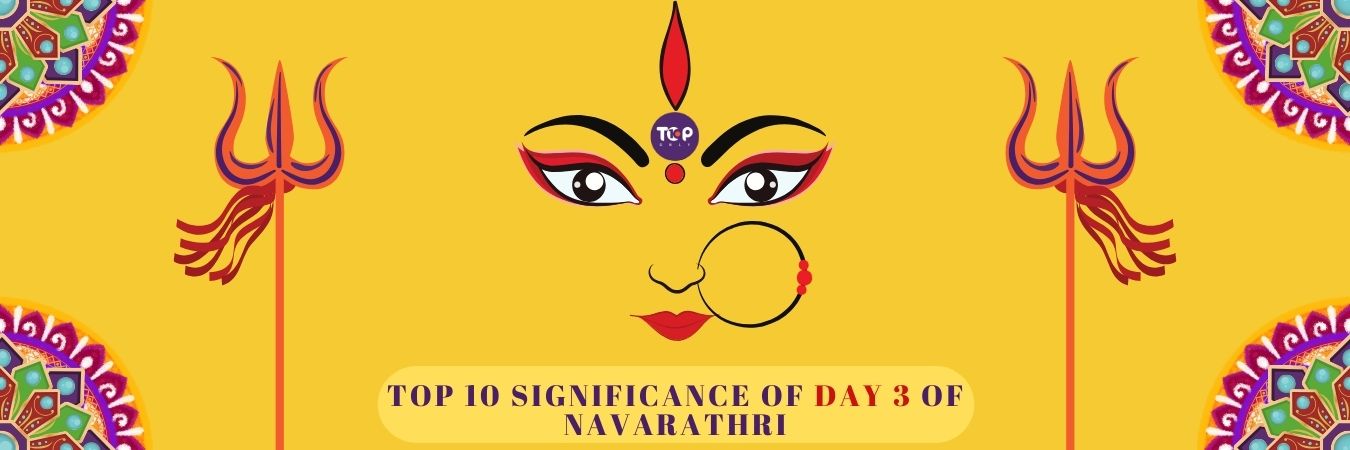Updated on: 12.09.2024

The festival of Navarathri holds a special place in the hearts of Hindu devotees worldwide. The main focus of the Navaratri festival lies in the worship of the Navadurga. The Navadurga are the nine scared Goddesses who are manifestations of the Goddess Maa Durga. Each day of Navarathri is dedicated to observing the traditional rituals ascribed to the Navadurga Goddess being commemorated on that particular day.
Top 10s Only presents a brief look at Day 3 of the Navarathri festival that will be celebrated on October 5, 2024 (Saturday).
If you’ve missed the significance of Day 2 of Navarathri, you can read about it here!
Significance Of Day 3 Of Navarathri
The significance of Day 3 of the Navarathri festival lies in Goddess Maa Chandraghanta’s bravery and courage. It is a belief that the Goddess Maa Durga’s manifestation in this form was for the protection and betterment of her devotees and society. Though Devi Maa Parvati’s nature is calm and peaceful, her avatar as Goddess Maa Chandraghanta is always ready to battle fearsome demons. The divine form of Goddess Maa Chandraghanta symbolizes justice and gives her devotees the courage to face challenges. She is known to bestow her devotees with bravery and courage. It is believed that her grace removes all the sins of her devotees.
1. The Name Of Goddess Worshipped On Day 3 Of Navarathri:
The third day of Navarathri is dedicated to the majestic Goddess Maa Chandraghanta. Her name is a blend of two words -‘Chandra’ means the moon, and ‘Ghanta’ means bell. In its entirety, the name Chandraghanta means ‘one who possesses a bell-shaped moon’. Maa Chandraghanta was given this name as she adorns her forehead with a bell-shaped half moon or Ardha Chandra. She is also called Carali Ambigai or Vaaraahi in South India and Chandika or Ranachandi in the North of the subcontinent.
The Goddess Maa Chandraghanta represents the married form of Devi Maa Parvati. As per Shiva Purana, she is Shakti – the better half of Lord Shiva.
2. The Speciality Of The Goddess Worshipped On Day 3 Of Navarathri
The magnificently radiant Goddess Maa Chandraghanta is depicted confidently riding a tiger or lion. The Devi has ten hands, eight of which are holding powerful weapons, while her remaining two hands display different postures. Goddess Maa Chandraghanta holds a Sword, Trishul, Gada, and Kamandala (sacred water pot) in her four left hands and keeps her fifth left hand in Varada Mudra (hand posture signifying compassion and blessing). The Devi carries a Lotus flower, Arrow, Dhanush and Japa Mala in her four right hands and keeps the fifth right hand in Abhaya Mudra (hand posture signifying courage and protection).
Goddess Maa Chandraghanta has a third eye at the centre of her forehead that is said to be open to protect her loyal devotees from evil and to kill evil demons. This compassionate Goddess is said to come to her faithful devotee’s rescue anytime and remove hurdles in seconds. She has a golden complexion, and Lord Shiva finds her to be a symbol of grace, beauty, and charm.
3. The Colour On Day 3 Of Navarathri
The Navarathri Day 3 colour is Grey. Grey shows the strength of transformation synonymous with the Devi, who is protective, charitable, brave, and has the capacity to destroy evil.
4. The Sweets To Be Offered On Day 3 Of Navarathri
Day 3 Navarathri naivedyam or prasadam offered to Goddess Maa Chandraghanta is Wheat Sakkarai Pongal. It is a divine-tasting Pongal made with broken wheat, dal, and jaggery.
5. The Snacks To Be Offered On Day 3 Of Navarathri
Ellu vella podi is a simple Day 3 Navarathri naivedyam prepared from sesame seeds and jaggery. It is a delicious dish that is simple to prepare. It is offered to Goddess Maa Chandraghanta, along with the other food items prepared for the day.
6. The Other Food Items To Be Offered On Day 3 Of Navarathri
Milk is a favourite of Goddess Maa Chandraghanta. Devotees offer it to the Goddess as it is or make it into a payasam as a Day 3 Navarathri offering. It is offered to the Devi to attain her blessings.
7. The Flowers To Be Offered On Day 3 Of Navarathri:
The fragrant Champangi (Shenbakam), Tuberose or Champak and Marikozhuthnu (Marjoram) are used while performing Day 3 Navarathri aarti, puja and other rituals. It’s a pleasing sight to watch the puja thalis loaded with these flowers and prasadams as offerings to the Goddess Maa Chandraghanta. These flowers are also used to decorate the house and puja area.
8. The Rangoli on Day 3 of Navarathri:
Rose or Lotus flower-themed rangolis, drawn using rice flour, is considered a significant way to welcome Goddess Maa Chandraghanta into the home. Therefore, colourful rangolis depicting the rose and lotus flowers are drawn at every house’s entrances or reception areas on the third day of Navarathri.
9. The Raaga On Day 3 Of Navarathri:
Singing devotional Navarathri chants and bhajans in ‘Kaambhodhi’ raagam is said to please the Goddess Maa Chandraghanta, as this raga conveys the sentiments of Shringara, Hasya, and Karuna.
10. The Belief on Day 3 of Navarathri:
It is believed that praying to Goddess Maa Chandraghanta helps ward off evils. Those who faithfully worship Devi Maa Chandraghanta are cleansed from all sins and are freed from mental & physical distress. The sound of her moon bell is said to strike fear in all demons, and the presence of her divine form drives away the dark forces of evil, allowing all her ardent devotees to live peaceful lives.
In short, the third day of Navarathri is dedicated to Goddess Chadraghanta. Devotees perform puja to invoke the Devi’s blessings in the hopes of gaining virtues like bravery and courage.
We hope we covered the importance of the third day of Navarathri for you. Let us know your thoughts in the comments below.
Want to know more about Navarathri traditions? Familiarise yourself with the customs associated with this magnificent festival by reading the Significance Of Day 4 Of Navarathri.


Pingback:Navarathri Day 4 Significance - Maa Kushmanda | Top 10s Only